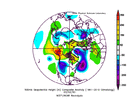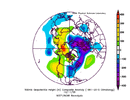lexxnchloe
Member
Still alot better than 06Z. Trended in the right didrection. Cold front faster and just need a few more adjustmentsWell it got shredded.
Sent from my iPhone using Tapatalk

Still alot better than 06Z. Trended in the right didrection. Cold front faster and just need a few more adjustmentsWell it got shredded.
Sent from my iPhone using Tapatalk

Still alot better than 06Z. Trended in the right didrection. Cold front faster and just need a few more adjustments

As I heard it once well described in a previous forum, there is a lot of “positively tilted trash” on the models. We need more consolidated energy at the base of this trough to get something.Frustrating part has been the favorable trends that just seem to stop short over and over. But yes no doubt a better look.
Sent from my iPhone using Tapatalk
I heard the pna was enough for snow and didn't need helpAs I heard it once well described in a previous forum, there is a lot of “positively tilted trash” on the models. We need more consolidated energy at the base of this trough to get something.
I miss -PNA induced Miller BsI heard the pna was enough for snow and didn't need help
I miss any semblance of a +pna/-naoI miss -PNA induced Miller Bs
Yes the entire month of January shows this .. but a -NAO always could help any winter pattern obviouslyI heard the pna was enough for snow and didn't need help
Actually January showed how having a +pna with no Atlantic blocking is going to verify faster/weakerYes the entire month of January shows this .. but a -NAO always could help any winter pattern obviously
Yep true and still scored 3 winter events .. I bet if we only had a -NAO we would have scored 3 cold rainsActually January showed how having a +pna with no Atlantic blocking is going to verify faster/weaker
Ok and I bet if we had a -nao/+pna we have a foot plus seasonal total instead of 3 mediocre events that seem to be top notch in your opinion. You've missed the point here but whateverYep true and still scored 3 winter events .. I bet if we only had a -NAO we would have scored 3 cold rains
Yep it's not that western ridges are a bad thing but they have small margins for error and typically accelerate the flow. Having a -nao in addition to the pna widens the margins for error and slows the flow. I'm fine with a western/pna ridge alone but I understand that it's going to take a near perfect setup to get a significant snow event from it.-NAO would have probably gave us some monster winter storms considering it would have slowed down the 50/50 low the first storm, slowed the flow with the second storm, and would have promoted slowed flow for digging with the 3rd. It’s a huge help
Ok and I bet if we had a -nao/+pna we have a foot plus seasonal total instead of 3 mediocre events that seem to be top notch in your opinion. You've missed the point here but whatever
Oh BTW we had 2 snow events last year with a -nao and whatever that pacific was so....
Here’s some actual data to consider about the importance of -NAO at RDU:
Here's the NAO for the 21 Raleigh 6"+ SN/IP storms since 1950. (I'm calling neutral NAO to be from +0.25 to -0.25):
-1/19/1955: -NAO
- 12/11/1958: neutral NAO
- 3/2-3/1960: neutral NAO
- 3/9/1960: neutral NAO
- 2/26/1963: neutral NAO
- 1/25-7/1966: -NAO
- 2/9/1967: +NAO
- 3/1/1969: -NAO
- 1/7-8/1973: -NAO
- 2/18-9/1979: neutral NAO
- 3/1-2/1980: +NAO
- 3/24/1983: neutral NAO
- 2/6/1984: +NAO
- 1/7-8/1988: +NAO
- 2/17-8/1989: +NAO
- 1/24-5/2000 (“Crusher”): -NAO
- 1/2-3/2002: -NAO
- 2/26-7/2004: -NAO
- 12/25-6/2010: -NAO
- 1/17-8/2018: +NAO
- 12/9-10/2018 +NAO
Tally:
-NAO: 8
Neutral NAO: 6
+NAO: 7
Though 2000-2010’s four big storms including the Crusher were all during -NAO, this shows a pretty even split through the entire period and the sample size isn’t small. Note that the last two were during +NAO as well as very notable storms like 3/1980 and 1/1988.
I don’t know. I’m admittedly a bit surprised the numbers are this balanced. Perhaps some of this is due to how the NCEP based NAO is defined/calculated. I mean I think you can still have good blocking near Greenland and it not officially be calculated as -NAO.
By the way, I also did a similar analysis for the NAO five days before each storm and the result didn’t change much with any -NAO advantage still small.


I never said the COMBO -nao and +pna is not the most ideal I have always agreed with that .. I said if we are going to have just 1 of these teleconnections on our side it should be the +PNA over the -NAO .. the events this year were not top notch and I never said that. we had one decent winter storm with 3-4 inches of snow, an ice storm, and then some novelty stuff. Still I find this winter much better than the 15 or so cold rains we got last year. But you are right we did get a 1.5 jackpot storm last year with the -NAO but that was it. Maybe since last year we had all -NAO and this year all +PNA next year we can have the beautiful combo!Ok and I bet if we had a -nao/+pna we have a foot plus seasonal total instead of 3 mediocre events that seem to be top notch in your opinion. You've missed the point here but whatever
Oh BTW we had 2 snow events last year with a -nao and whatever that pacific was so....
This is great I wonder what the real data says about +PNAs past couple decades. Thanks for the research!Here’s some actual data to consider about the importance of -NAO at RDU:
Here's the NAO for the 21 Raleigh 6"+ SN/IP storms since 1950. (I'm calling neutral NAO to be from +0.25 to -0.25):
-1/19/1955: -NAO
- 12/11/1958: neutral NAO
- 3/2-3/1960: neutral NAO
- 3/9/1960: neutral NAO
- 2/26/1963: neutral NAO
- 1/25-7/1966: -NAO
- 2/9/1967: +NAO
- 3/1/1969: -NAO
- 1/7-8/1973: -NAO
- 2/18-9/1979: neutral NAO
- 3/1-2/1980: +NAO
- 3/24/1983: neutral NAO
- 2/6/1984: +NAO
- 1/7-8/1988: +NAO
- 2/17-8/1989: +NAO
- 1/24-5/2000 (“Crusher”): -NAO
- 1/2-3/2002: -NAO
- 2/26-7/2004: -NAO
- 12/25-6/2010: -NAO
- 1/17-8/2018: +NAO
- 12/9-10/2018 +NAO
Tally:
-NAO: 8
Neutral NAO: 6
+NAO: 7
Though 2000-2010’s four big storms including the Crusher were all during -NAO, this shows a pretty even split through the entire period and the sample size isn’t small. Note that the last two were during +NAO as well as very notable storms like 3/1980 and 1/1988.
I don’t know. I’m admittedly a bit surprised the numbers are this balanced. Perhaps some of this is due to how the NCEP based NAO is defined/calculated. I mean I think you can still have good blocking near Greenland and it not officially be calculated as -NAO.
By the way, I also did a similar analysis for the NAO five days before each storm and the result didn’t change much with any -NAO advantage still small.
